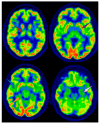Fibromyalgia in the Era of Brain PET/CT Imaging
- PMID: 40565912
- PMCID: PMC12194720
- DOI: 10.3390/jcm14124166
Fibromyalgia in the Era of Brain PET/CT Imaging
Abstract
Fibromyalgia syndrome (FMS) is a complex, heterogeneous disorder characterized by chronic widespread pain, fatigue, and cognitive disturbances. The multifactorial nature of FMS, with the involvement of central and peripheral mechanisms, hampers diagnosis and effective treatment. In recent years, positron emission tomography (PET) imaging has emerged as a valuable tool for exploring the neurobiological underpinnings of FMS. Several studies have investigated alterations in glucose metabolism, neurotransmitter systems (including opioid, dopamine, and GABAergic pathways), and neuroinflammation using various PET tracers. These findings have revealed distinct brain metabolic and molecular patterns in FMS patients compared to healthy controls, particularly in pain-related regions such as the thalamus, insula, and anterior cingulate cortex (ACC). Moreover, preliminary data suggest that PET imaging may help identify FMS subgroups with different pathophysiological profiles, potentially allowing for tailored therapeutic approaches. This review summarizes the current evidence on PET applications in FMS and discusses the potential role of molecular imaging in improving patient stratification and predicting treatment response.
Keywords: PET/CT; brain; central nervous system; fibromyalgia syndrome.
Conflict of interest statement
The authors declare no conflicts of interest.
Figures




Similar articles
-
The value of FDG positron emission tomography/computerised tomography (PET/CT) in pre-operative staging of colorectal cancer: a systematic review and economic evaluation.Health Technol Assess. 2011 Sep;15(35):1-192, iii-iv. doi: 10.3310/hta15350. Health Technol Assess. 2011. PMID: 21958472 Free PMC article.
-
NIH Consensus Statement on Management of Hepatitis C: 2002.NIH Consens State Sci Statements. 2002 Jun 10-12;19(3):1-46. NIH Consens State Sci Statements. 2002. PMID: 14768714
-
Positron emission tomography (PET) and magnetic resonance imaging (MRI) for the assessment of axillary lymph node metastases in early breast cancer: systematic review and economic evaluation.Health Technol Assess. 2011 Jan;15(4):iii-iv, 1-134. doi: 10.3310/hta15040. Health Technol Assess. 2011. PMID: 21276372 Free PMC article.
-
Exercise for treating fibromyalgia syndrome.Cochrane Database Syst Rev. 2007 Oct 17;(4):CD003786. doi: 10.1002/14651858.CD003786.pub2. Cochrane Database Syst Rev. 2007. PMID: 17943797
-
Whole body vibration exercise training for fibromyalgia.Cochrane Database Syst Rev. 2017 Sep 26;9(9):CD011755. doi: 10.1002/14651858.CD011755.pub2. Cochrane Database Syst Rev. 2017. PMID: 28950401 Free PMC article.
References
Publication types
LinkOut - more resources
Full Text Sources
Miscellaneous

